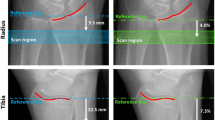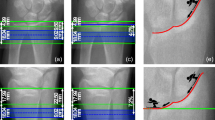Abstract
We evaluated the accuracy and precision of a peripheral quantitative computed tomography (pQCT) scanner, the Stratec XCT-960, using 12 human cadaveric forearms. The accuracy was determined by comparing the total bone mineral content (BMC) with the ash weight (AW). We scanned and ashed three consecutive slices (thickness 2.5 mm) at the standard position (s-position) and at 2.5 mm both proximal and distal to the s-position. The correlation coefficient between the AW and total BMC using slices at the s-position wasr=0.87 with an accuracy error (random component) of 15.5%. The correlation coefficient using all slices wasr=0.90 with an accuracy error of 14.3%. The correlation coefficient improved tor=0.95 with an accuracy error of 9.7% after averaging the results of all three slices for each forearm. The short-term precision error expressed as the coefficient of variation (CV) of bone mineral density (BMD) and BMC was determined by measuring the forearms five times either with repositioning or without repositioning. The CVs with repositioning were 2.77 and 1.15 for total BMD and BMC, 1.85 for trabecular BMD; without repositioning they were 0.29, 0.58 and 0.69 respectively. To further evaluate the influence of positioning, additional scans were performed at 1, 2 and 5 mm proximal, and 1 and 2 mm distal to the s-position. BMD and BMC were greatly influenced by the scan location; for example, the percentage differences in trabecular BMD 1 mm distal and proximal relative to the s-position were 2.5%±5.1% and 0.18%±6.3%, respectively. The Stratec XCT-960 appears to be a moderately accurate and highly precise scanner with potential usefulness for evaluating BMC and BMD of ultradistal radius.
Similar content being viewed by others
References
Larcos G. Wahner HW. An evaluation of forearm bone mineral measurement with dual-energy x-ray absorptiometry. J Nucl Med 1991;32:2101–6.
Weinstein RS, New KD, Sappington LJ. Dual-energy x-ray absorptiometry versus single photon absorptiometry of the radius. Calcif Tissue Int 1991;49:313–6.
Nelson D, Feingold M, Mascha E, Kleerekoper M. Comparison of single-photon and dual-energy x-ray absorptiometry of the radius. Bone Miner 1992;18:77–83.
Nieves JW, Cosman F, Mars C, Lindsay R. Comparative assessment of bone mineral density of the forearm using single photon and dual x-ray absorptiometry. Calcif Tissue Int 1992;51:352–5.
Leboff MS, Fuleihan GE, Angell JE, Chung S, Curtis K. Dual-energy x-ray absorptiometry of the forearm: reproducibility and correlation with single-photon absorptiometry. J Bone Miner Res 1992;7:841–6.
Faulkner KG, McClung MR, Schmeer MS, Roberts LA, Gaither KW. Densitometry of the radius using single and dual energy absorptiometry. Calcif Tissue Int 1994;54:208–211.
Kelly TL, Crane G, Baran DT. Single x-ray absorptiometry of the forearm: precision, correlation, and reference data. Calcif Tissue Int 1994;54:212–8.
Rüegsegger P, Elsasser U, Anliker M, Gnehm H, Kind H, Prader A. Quantification of bone mineralization using computing tomography. Radiology 1976;121:93–7.
Rüegsegger P. Quantitative computed tomography at peripheral measuring sites. Ann Chir Gynaecol 1988;77:204–7.
Müller A, Rüegsegger E, Rüegsegger P. Peripheral QCT: a low-risk procedure to identify women predisposed to osteoporosis. Phys Med Biol 1989;34:741–9.
Schneider P, Börner W. Peripheral quantitative computed tomography for bone mineral measurement with a new special purpose QCT-scanner: method, normal references, comparison to osteoporotic patients. Fortschr Rontgenstr 1991;154:292–9.
Hangartner TN, Battista JJ, Overton TR. Performance evaluation of density measurements of axial and peripheral bone with x-ray and gamma-ray computed tomography. Phys Med Biol 1987;32:1393–406.
Rüegsegger P, Durand E, Dambacher MA. Localization of regional forearm bone loss from high resolution computed tomographic images. Osteoporosis Int 1991;1:76–80.
Pearson J, Rüegsegger P, Dequeker J, et al. European semi-anthropomorphic phantom for the cross-calibration of peripheral bone densitometers: assessment of precision, accuracy and stability. Bone Miner 1994;27:109–20.
Glüer CC, Reiser UJ, Davis CA, Rutt BK, Genant HK. Vertebral mineral determination by quantitative computed tomography (QCT): accuracy of single and dual energy measurements. J Comput Assist Tomogr 1988;12:242–58.
Hagiwara S, Engelke K, Yang S-O, et al. Dual x-ray absorptiometry forearm software: accuracy and intermachine relationship. J Bone Miner Res 1994;9:1425–7.
Lehmann R, Wapniarz M, Kvasnicka HM, Baedeker S, Klein K, Allolio B. Reproducibility of bone density measurements of the distal radius using a high resolution special scanner for peripheral quantitative computed tomography (single energy pQCT). Radiologe 1992;32:177–81.
Burtz S, Wüster C, Scheidt-Nave C, Götz M, Ziegler R. Forearm BMD as measured by peripheral quantitative computed tomography (pQCT) in a German reference population. Osteoporosis Int 1994;4:179–84.
Grampp S, Lang P, Jergas M, et al. Assessment of the skeletal status by peripheral quantitative computed tomography: short-term precision in-vivo and comparison to dual x-ray absorptiometry. J Bone Miner Res 1995;10:1566–76.
Romero J, Dambacher MA, Neff M, Feider M, Rüegsegger P. Trabecular and cortical bone: two different systems? J Bone Miner Res 1995;10 (Suppl 1):S470.
Author information
Authors and Affiliations
Rights and permissions
About this article
Cite this article
Takada, M., Engelke, K., Hagiwara, S. et al. Accuracy and precision study in vitro for peripheral quantitative computed tomography. Osteoporosis Int 6, 207–212 (1996). https://doi.org/10.1007/BF01622736
Received:
Accepted:
Issue Date:
DOI: https://doi.org/10.1007/BF01622736




